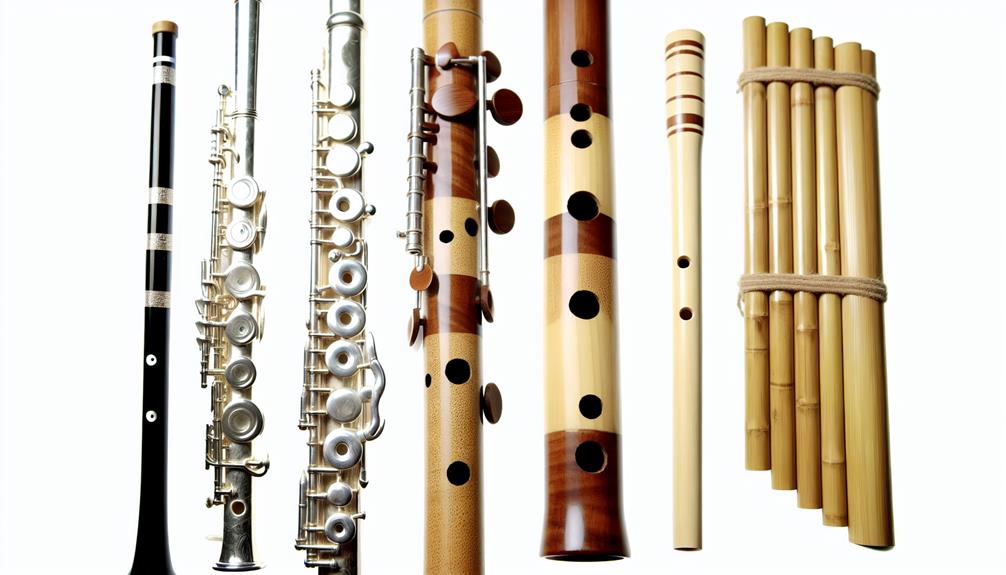In the realm of woodwind instruments, there exists a family of flutes that showcases a diverse range of pitches and tonal qualities. From the familiar Concert Flute to the intriguing Contrabass Flute, each member of this quintet brings its own unique characteristics to the ensemble.
These five flutes, with their distinct sizes and registers, play a crucial role in orchestral settings, chamber music performances, and solo repertoire. But what exactly distinguishes each flute from the other, and how do they contribute to the rich tapestry of musical compositions?
Let's explore the world of flutes beyond the Concert Flute and uncover the nuances that make each of these instruments special.
Key Takeaways
- Concert Flute: Timeless and versatile with a rich tonal quality, beloved for its clear and vibrant sound.
- Piccolo: Adds a bright and lively element, crucial in marching bands and orchestras.
- Alto Flute: Offers a rich and mellow tone, expanding the range and depth of ensembles.
- Bass Flute: Renowned for its deep and resonant tone, often used in orchestral settings.
Concert Flute
The elegance of the Concert Flute lies in its timeless versatility and rich tonal quality. As one of the most widely recognized and beloved instruments in the flute family, the Concert Flute holds a special place in the hearts of musicians and audiences alike. Its clear and vibrant sound has the power to evoke a sense of nostalgia and belonging, making it a popular choice for orchestras, chamber ensembles, and solo performances.
Crafted from silver, gold, or other high-quality materials, the Concert Flute produces a warm and expressive tone that can effortlessly transition between genres and styles. From classical symphonies to contemporary jazz and pop music, this flute adapts to various musical settings with grace and sophistication.
Whether played by seasoned professionals or aspiring musicians, the Concert Flute offers a sense of unity and connection through its beautiful melodies and harmonious timbre. Its ability to convey emotions and tell stories through music makes it a timeless symbol of artistic expression and cultural heritage.
Piccolo
Known for its distinctive high-pitched sound and compact size, the Piccolo is a unique member of the flute family that stands out for its piercing clarity and agility. Despite its small size, the Piccolo plays an essential role in marching bands, orchestras, and concert bands, adding a bright and lively element to musical compositions.
Key Features of the Piccolo:
- Octave Higher: The Piccolo is pitched an octave higher than the standard concert flute, producing a bright and almost whistle-like tone that cuts through other instruments.
- Woodwind Family: While the Piccolo is technically a member of the woodwind family due to its use of a lip plate to produce sound, it is predominantly made of metal like silver or nickel silver.
- Fingering System: The fingering system of the Piccolo is similar to the concert flute, making it easier for flutists to switch between the two instruments seamlessly.
Alto Flute
An essential and versatile member of the flute family, the Alto Flute offers a rich and mellow tone that expands the range and depth of musical ensembles. This instrument is larger than the traditional concert flute and is pitched in the key of G, producing a sound a perfect fourth lower than the regular C flute. The Alto Flute is a popular choice among flutists for its unique timbre and ability to add a warm, sonorous quality to various musical pieces.
To understand the Alto Flute better, let's explore some key characteristics:
| Characteristic | Description | Benefits |
|---|---|---|
| Size | Larger than the concert flute, offering a deeper, mellower tone. | Enhances the depth and richness of music. |
| Pitch | Tuned in the key of G, producing a sound a perfect fourth lower than the C flute. | Allows for a wider range of notes. |
| Material | Typically made of silver-plated brass or silver, ensuring durability and quality sound. | Provides longevity and professional sound. |
Bass Flute
A significant member of the flute family, the Bass Flute is renowned for its deep and resonant tone that enriches musical compositions across various genres. This instrument plays a vital role in adding depth and richness to musical ensembles, expanding the tonal range and enhancing the overall sound quality.
Key Points about the Bass Flute:
- Size and Range: The Bass Flute is larger than the standard C flute and is pitched one octave below. Its extended length allows for lower notes to be produced, contributing a distinctive timbre to musical pieces.
- Construction: Typically made of metal or silver, the Bass Flute features a curved headjoint to facilitate playing the lower notes comfortably. Its design enables players to achieve a smooth and seamless transition between registers.
- Usage in Music: Due to its unique sound characteristics, the Bass Flute is often employed in orchestral settings, chamber music, and contemporary compositions to provide a rich foundation and add a touch of elegance to the music.
Contrabass Flute
The Contrabass Flute, a remarkable member of the flute family, distinguishes itself with its exceptionally deep and resonant tones, further expanding the lower register capabilities beyond that of the Bass Flute. As the largest and lowest-pitched instrument in the flute family, the Contrabass Flute produces rich and velvety sounds that add a unique depth to ensembles and compositions. Its impressive size, often reaching over 8 feet in length, contributes to the production of these distinctive tones.
While less common than its smaller counterparts, the Contrabass Flute offers a dynamic range that is unparalleled in its ability to anchor the lower end of musical arrangements. Its commanding presence and ability to resonate with power make it a sought-after addition in orchestras, chamber music groups, and contemporary music settings. Despite its size, skilled musicians navigate its keys and intricate mechanisms with finesse, harnessing its full potential to create a sonorous foundation for musical pieces. The Contrabass Flute stands as a testament to the versatility and range of expression found within the flute family, captivating audiences with its deep, soul-stirring timbre.
Frequently Asked Questions
What Are the Most Common Materials Used to Make Flutes?
The most common materials used to make flutes are wood, metal, and plastic.
Wood, such as grenadilla, rosewood, and cedar, is favored for its warm tone and traditional feel.
Metal flutes, often made of silver or nickel, offer a brighter sound and are popular in classical music.
Plastic flutes are durable, affordable, and suitable for beginners.
Each material has its unique characteristics, catering to various player preferences and musical styles.
How Does the Size of a Flute Affect Its Sound?
The size of a flute plays a significant role in shaping its sound. Larger flutes tend to produce lower pitches with a deeper, richer tone, while smaller flutes produce higher pitches with a brighter, more delicate sound.
The size affects the volume, timbre, and overall character of the sound produced by the flute. Understanding how the size influences sound production is essential for musicians seeking to achieve a desired musical expression.
Are There Any Famous Flute Players Who Have Made Significant Contributions to the Instrument?
When considering famous flute players who have significantly contributed to the instrument, one cannot overlook the impact of Sir James Galway. Renowned for his virtuosity and distinctive tone, Galway has not only elevated the flute's status but has also inspired countless musicians worldwide.
His career, spanning over six decades, has left an indelible mark on the world of classical music. This serves as a testament to the enduring influence of exceptional artists in the realm of flute performance.
Can Flutes Be Used in Genres of Music Other Than Classical?
Flutes are versatile instruments that can transcend beyond classical music into a variety of genres. Their sweet, airy tones make them popular in jazz, folk, pop, and even world music.
Flutists have successfully incorporated this instrument into different styles, showcasing its adaptability and unique sound. With its ability to convey emotion and melody, the flute adds a distinctive touch to compositions across various musical genres.
Are There Any Unique Techniques or Extended Techniques Commonly Used by Flute Players?
Flute players often employ unique techniques, known as extended techniques, to expand the sonic possibilities of their instruments. These techniques can include flutter-tonguing, harmonics, multiphonics, and percussive effects.
Additionally, flute players may utilize circular breathing to produce continuous sound. These techniques are commonly used in various genres of music, adding depth and creativity to the flute's repertoire.
Conclusion
In conclusion, the five types of flutes are the Concert Flute, Piccolo, Alto Flute, Bass Flute, and Contrabass Flute. Each flute has its own unique sound and range, contributing to the diverse and rich sound palette of the flute family.
Just as a symphony orchestra is made up of various instruments, each with its own purpose and role, the different flutes work together harmoniously to create beautiful music that resonates with listeners around the world.

